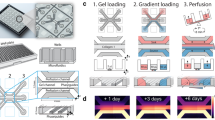Abstract
The water-conducting network of capillaries in vascular plants has evolved over hundreds of millions of years in order to be able to cope with bubble clogging, a problem which also affects modern microfluidic devices. Decades of anatomical studies have revealed that plants growing in habitats in which the formation of bubbles, or emboli, is likely to be a frequent occurrence often have various forms of geometrical sculpturing on the internal surfaces of the xylem conduits. The possible function of such wall sculpturing has long been the subject of speculation. We have investigated the hypothesis that wall sculpturing is a functional adaptation designed to increase the wettability of the walls of xylem conduits, an effect which could be described as the inverse of the well-known lotus-effect. Our results show that wall sculpturing does enhance wettability. Importantly, theoretical calculations reveal that the geometric parameters of various types of wall sculpturing are such that the resulting surfaces are sufficiently rough to enhance wettability, but not significantly rougher. The results provide an appealing answer to the long-standing debate on the function of wall sculpturing in xylem conduits, and may provide biomimetic clues for new approaches to the removal of bubbles in microfluidic channels.
Similar content being viewed by others
References
Dixon H H. Transpiration and the Ascent of Sap in Plants, MacMillan, London, 1914.
Tyree M T, Zimmermann M H. Xylem Structure and the Ascent of Sap, 2nd ed, Springer, Berlin, 2002.
Pickard W F. The ascent of sap in plants. Progress in Biophysics and Molecular Biology, 1981, 37, 181–229.
Pickard W F, Melcher P J. Perspectives on the biophysics of xylem transport. In: Zwieniecki M A, Holbrook N M (eds). Vascular Transport in Plants, Elsevier, Burlington, 2005, 3–18.
Clearwater M J, Goldstein G. Embolism repair and long distance water transport. In: Zwieniecki M A, Holbrook N M (eds). Vascular Transport in Plants, Elsevier, Burlington, 2005, 375–399.
Zwieniecki M A, Holbrook N M. Bordered pit structure and vessel wall surface properties. Implications for embolism repair. Plant Physiology, 2000, 123, 1015–1020.
Jansen S, Baas P, Gasson P, Smets E. Vestured pits: Do they promote safer water transport? International Journal of Plant Sciences, 2003, 164, 405–413.
Choat B, Jansen S, Zwieniecki M A, Smets E, Holbrook N M. Changes in pit membrane porosity due to deflection and stretching: The role of vestured pits. Journal of Experimental Botany, 2004, 55, 1569–1575.
Konrad W, Roth-Nebelsick A. The significance of pit shape for hydraulic isolation of embolised conduits of vascular plants during novel refilling. Journal of Biological Physics, 2005, 31, 57–71.
Carlquist S J. Comparitive Wood Anatomy: Systematic, Ecological, and Evolutionary Aspects of Dicotyledon Wood, Springer, Berlin, 1988.
Baas P. Ecological patterns in xylem anatomy. In: Givnish J (ed). On the Economy of Plant Form and Function, Cambridge University Press, Cambridge, 1986, 327–353.
Meylan B A, Butterfield B G. Occurrence of helical thickenings in the vessels of New Zealand woods. New Phytologist, 1978, 81, 139–146.
Carlquist S. Wood anatomy of Onagraceae: Further species; root anatomy; significance of vestured pits and allied structures in dicotyledons. Annals of the Missouri Botanic Garden, 1982, 69, 755–769.
Heady R D, Cunningham R B, Donnelly C F, Evans P D. Morphology of warts in the tracheids of cypress pine (Callitris Vent.). Journal of the International Association of Wood Anatomists, 1994, 15, 265–281.
Kohonen M M. Engineered wettability in tree capillaries. Langmuir, 2006, 22, 3148–3153.
Quéré D. Wetting and Roughness. Annual Review of Materials Research, 2008, 38, 71–99.
Sun T, Feng L, Gao, X, Jiang L. Bioinspired surfaces with special wettability. Accounts of Chemical Research, 2005, 38, 644–652.
Fogg G E. Quantitative studies on the wetting of leaves by water. Proceedings of the Royal Society of London B, Biological Sciences, 1947, 134, 503–522.
Barthlott W, Neinhuis C. Purity of the sacred lotus, or escape from contamination in biological surfaces. Planta, 1997, 202, 1–8.
Bohn H F, Federle W. Insect aquaplaning: Nepenthes pitcher plants capture prey with the peristome, a fully wettable water-lubricated anisotropic surface. Proceedings of the National Academy of Sciences of the USA, 2004, 101, 14138–14143.
Kohnle J, Waibel G, Cernosa R, Stow M, Ernst H, Sandmaier H, Strobelt T, Zengerle R. A unique solution for preventing clogging of flow channels by gas bubbles. Proceedings of the IEEE International Conference on Microelectromechanical Systems, Las Vegas, USA, 2002, 77–80.
Chung S, Yun H, Kamm R D. Nanointerstice-drive microflow. Small, 2009, 5, 609–613.
Author information
Authors and Affiliations
Corresponding author
Rights and permissions
About this article
Cite this article
Kohonen, M.M., Helland, Å. On the Function of Wall Sculpturing in Xylem Conduits. J Bionic Eng 6, 324–329 (2009). https://doi.org/10.1016/S1672-6529(08)60131-6
Published:
Issue Date:
DOI: https://doi.org/10.1016/S1672-6529(08)60131-6




